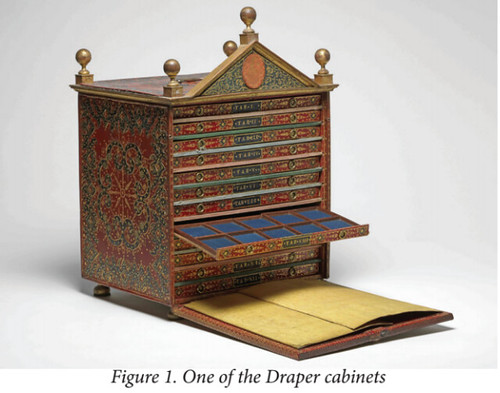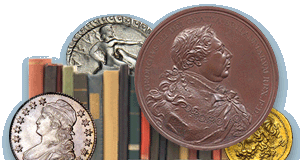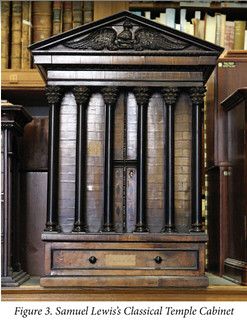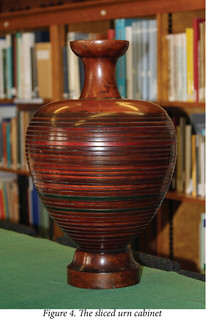
PREV ARTICLE
NEXT ARTICLE
FULL ISSUE
PREV FULL ISSUE
COIN CABINETS
Coin cabinets are the focus topic of the September 2016 Money & Medals issue. This is a fascinating topic - many classic coin
storage cabinets are wonderful pieces of furniture and even works of art themselves. here are some excerpts. -Editor
This month we celebrate one of the essential, if sometimes overlooked, parts of any numismatic collection - the cabinets which house coins and medals. Henry Flynn details the results of his exploration of museum numismatic collections in the UK, Adrian Popescu focuses on the cabinets of the Fitzwilliam Museum and Donal Bateson discusses some famous eighteenth century cabinets. Approaches to Housing Numismatic Study Collections
A marvellous example of a historic coin cabinet still being used to house a collection can be found at the Victoria Gallery & Museum in Liverpool, the full details of which are described below by their Documentation Assistant Jade Ryan: “Here at the Victoria Gallery and Museum, we were blessed to find our numismatic collection in an outstanding cabinet. Not only do we have this amazing cabinet but we know exactly where it came from, down to the wood it’s made from. Whilst carrying out a coin inventory I found a secret compartment in the top, within which were housed objects that couldn’t fit elsewhere in the cabinet; like hat money with its original label, medal certificates, and a lovely letter from one of the cabinet’s first owners. The letter tells us the story of how the wood was transformed into the cabinet it is today. It started off as a cross on top of St. Peter’s Church in Wolverhampton, however this was struck by lightning in 1840 and split. When it was cut down the wood was taken to cabinet maker Thomas Clear from Darlington Street, and stored in his yard until he turned it into a wonderful cabinet for the alderman J. S. Simkiss. After Simkiss’s passing his son sold it. In turn it was bought by the author of our letter, Mr Joseph G Wright, although he never finished the date of the letter and wrote 188. This is unfortunately as far as the story goes as we don’t know how it came to our donors The Gregson Memorial Institute revealing a gap in its history.” Cabinets at the Fitzwilliam Museum
The numismatic collections accumulated by the University of Cambridge and by the Colleges since the earliest recorded bequest (in 1589, that of Andrew Perne, Master of Peterhouse), are housed in the Department of Coins and Medals at the Fitzwilliam Museum. Despite this early record, it was not until 1744 that a cabinet was specifically mentioned, belonging to Roger Gale of Trinity College. Nowadays the collections are stored in a variety of cabinets ranging from the 18th century wooden examples to the current state of the art versions, made of conservation grade materials. The majority of the cabinets were manufactured in the second half of the 19th century and throughout much of the 20th century and most of them, with very few exceptions, are purely functional. 
There are a few extravagant coin cabinets which are impressive in their design, materials used and execution. Of these, the earliest one (figs. 1-2) is a rather unusual English coin cabinet, made around 1745, which belonged to William Draper of the Addiscombe Estate near Croydon, a relative of John Evelyn. This cabinet is one of a pair and it is unusual in that it is made out of wood covered with coloured and gilded ‘on- laid’ red morocco leather. It has silver carrying handles, pull-down fronts and a fold-out leather tray list, which is divided by vertical lines for chalk notes for the twelve trays which have decorated leather fronts and gilt copper alloy drawer pulls. The identity of the owner is indicated by the Draper arms (London, granted 1618) applied to the pediments. The owner had the cabinet made by an unidentified craftsman from a London workshop which was producing this kind of leather-work for book bindings. The cabinet was recorded as being sold in April 1760 by a Mr Langford and in 1864 was given to the museum by A.A. Vansittart of Trinity College.
It is veneered in walnut, mahogany and ebony and has moulded and carved details in mahogany and ebony but also copper alloy parts. In the pediment, hidden behind an eagle with spread wings, there is a ‘secret’ tray.
I was fascinated by these cabinets during my visit to the Fitzwilliam in 2007. I want one! -Editor
To subscribe by email to the Money & Medals newsletter, send your name and email address to the editor at
newsletter@moneyandmedals.org.uk -Editor
To read the earlier E-Sylum articles, see:
Wayne Homren, Editor The Numismatic Bibliomania Society is a non-profit organization promoting numismatic literature. See our web site at coinbooks.org. To submit items for publication in The E-Sylum, write to the Editor at this address: whomren@gmail.com To subscribe go to: https://my.binhost.com/lists/listinfo/esylum All Rights Reserved. NBS Home Page Contact the NBS webmaster 
|

